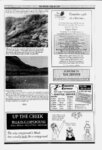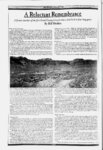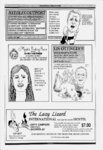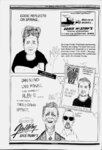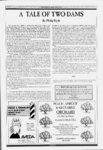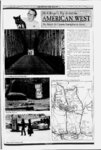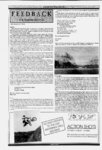| OCR Text |
Show ? $ ?a $U M 4'M m $ & county now has a fair, evenhanded pay scale and good personnel policies that should help us avoid die expensive lawsuits that have resulted from questionable hiring and firing in the past. All contracts are bid out with detailed specifications so we get the right job done at the right price. We have a realistic economic development process. And with Earl Sires writing grant proposals, the county has been getting about seventy times as much grant revenue as it did in days. Moreover, now that the county has a to the professional counterpart city manager, communication and cooperation between the two governments is improving. For instance, all units of load government have been collaborating on a capital facilities plan. Basically, this involves deckling what quality of service we want in all the fundamental areas (How long, for example, do you want to wait for a fire engine if the woodstove goes thermonuclear?). Once we know that, growth projections tell us when we need to plan to build a new fire station or upgrade the water system. Such studies are crucial for orderly planning and convincing appeals to state and federal funding sources. They also form the basis for legally defensible impact fees that will help make growth pay its own way. We are years ahead of most other rural western communities in this endeavor, but both the Gty and County still have to formally adopt the study and pass an impact fee ordinance. A little dose attention by the electorate wouldn't hurt If the capital facilities plan exemplifies what we should be doing, then the current squabble over development on the north end of town is a perfect example of what we ought to avoid. Here, everything has broken down. Large commercial properties are supposed to get their munidpal services from dties; a belief that is embedded in all parts of the Utah system of government. The north end developments should be connected to city water and sewer, and they should pay a fair price for it. Instead, because the city and county don't have a systematic approach to annexation, and because the developers were smart enough to pick a nice local person to represent them, we seem likely to end up with motels, camparks, restaurants and a shopping district right next to the dty, but hooked-u- p to a Rube Goldberg private sewer plant discharging directly into the slough. Through the magic of a special service district, the developers have worked the conjurers trick of escaping dty taxes while competing with local government for state and federal subsidies. They have even managed to transfer ultimate responsibility for the success of their bargain basement system to county government. If the state or the EPA finds that discharges are polluting the wetland, the taxpayers could provide the deep This scenario, in which we foul our own nest and gp broke doing it, pockets for dean-uis straight from the worst of all possible worlds. p. Public Lands Almost all of us can agree that one of the best things about living here is the magnificent country. . .. Rill stop. Beyond that, there is nearly universal disagreement about how the public lands should be managed. Opinions were all over the map in the hearings on Wilderness proposals for our area. All these decisions require compromise and a difficult public process. Is it not curious then, that the county coundl acts as though there is clear consensus supporting an agenda? They have just spent thousands of tax dollars hiring a $200 per hour wise-us-e lobbyist to represent us in Washington. Thousands more were spent joining a lawsuit opposing the BLM's Wilderness even though that process was designed to inform us about the lands in dispute. Heaven forbid that we should know what we're talking about! We do know where this approach leads: San Juan County, with its lawsuits over roads and condors, now has the distinction of having the highest tax rate in the state. Our county rate is 38 lower, but maybe we can catchup. The better way for local people to have a say in how the public lands are run is for them to be constructively involved in the decision making process. When counties drop the dogma and try to solve problems, as Grand County did at Sandflats or in the Wilderness process, those reasonable proposals have powerful credibility all the way up the hierarchy. The Canyon Country Partnership is a readily available vehicle for placing local concerns front and center in discussions of state and federal land management. It simply requires the commitment to be at the table instead of taking potshots from the sidelines. Smugly talking about local rights, like some council members do, is unproductive at best, and risks unilateral responses such as President Clinton's national monument designation. vV: Here are three examples of the kinds of issues coming up in public land management that beg for constructive community involvement: First, Representative Chris Cannon has expressed interest in expanding Arches to include the Lost Spring Canyon area. There are significant wilderness and grazing issues involved, but they should be resolvable. The county could take a lead in adding these beautiful canyons to the park. Second, bitter dispute about road issues disguises the fact that only a small percentage of actual roads are controversial The Canyon Country Partnership is considering a way of cutting the problem down to size by developing a process that acknowledges clearly established roads. Once the majority of the county's transportation network is recognized, it should be possible to realty study the disputed roads on a factual rather than ideological basis. And third, Arizona Senator John McCain has recently introduced an aircraft overflights bill This legislation applies lessons learned at the Grand Canyon to other national parks by allowing them to establish standards for natural quiet It would be wonderful if we could get ahead of the curve and develop a local plan to protect existing operators while preventing the scenic air tour circus that has plagued other areas. Growth Management My four years on the council convinced me that there is very little that can be done to successfully control growth. Places that try do it quickly become exclusive and expensive, vaporizing the existing community. And in Moab, State Trust Lands and the San Juan part of Spanish Valley present a ready escape clause from any regulations considered too restrictive. It is possible, though, to plan for and manage growth, and if we don't do that we are climbing on a greased slide to the worst of all possible worlds. Let me explain, because I mean something very specific here. The Moab valley is likely to hold more than 30,000 residents in the next several decades. We can have that many without any more zone changes. Just look at an aerial roads and flooding problems. photograph...the valley is a narrow place, with badly laid-ocould or our Explosive growth easily deplete pollute groundwater, and we are almost sure to destroy our views with development all over the hillsides and mesas. What's more, if we keep hoping growth will go away or refuse to plan for it because planning is socialism, then we won't extend services in a logical and economical sequence. Flood control will always be the problem of the neighbors downhilL We won't zone areas for high density affordable housing, and we won't purchase land for future fire stations, libraries, parks and sewer easements until it's too late. And, if we fail to do all those things, the growth that makes Moab ugly and unsafe will also be the growth that taxes us out of house and home. And that is what I mean by the worst of all worlds. As an alternative, I can suggest nothing more glamorous than sensible planning that is focused on providing an adequate infrastructure, and making the developers pay their fair share through impact fees and enforcement of a good subdivision ordinance. However, if that endeavor is coupled with productive relationships with the state and federal land management agencies, then Moab can continue to be a haven for a diverse, culturally active community in the middle of some of the best country on earth. And that still seems worth fighting for. ut non Former County Councilman famUy in Castle Valley. BUI Hedden works In the for the Grand Canyon Trust. He JnncJuly Issue of the Canyon Country Zephyr: OUR FRIENDS WERE DEARER THEN Remembering Lives that Touched the Canyon Country BROWNTROUT is proud to support IMAGES IN STONE wise and visionary By David Muench efforts to drain the abomination With introduction by Polly Schaafsma ailed Lake Powell and restore Superb reproductions convey the rock art panels of North America, their aesthetic power and beauty revealed by the astounding photographic art of David Muench. Polly Schaafsma writes about the Glen Canyon to the wild and living river it once was. historic peoples whose worldviews are rcccaled in this fascinating book. And we'd like to see it happen in our lifetime. FOR MORE ABOUT BROWNTROUT CALL 800-950-78- Hoes with his . |




